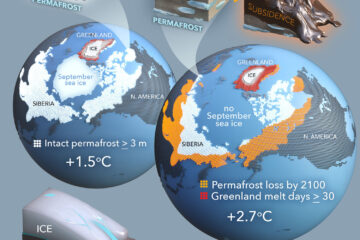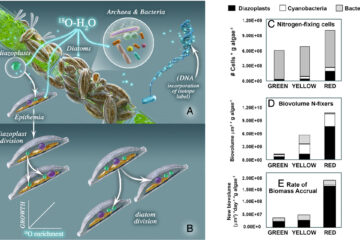Ammonia oxidation, denitrification and dissimilatory nitrate reduction to ammonium in two US Great Basin hot springs with abundant ammonia‐oxidizing archaea
Many thermophiles catalyse free energy-yielding redox reactions involving nitrogenous compounds; however, little is known about these processes in natural thermal environments. Rates of ammonia oxidation, denitrification and dissimilatory nitrate reduction to ammonium (DNRA) were measured in source water and sediments of two ∼80°C springs in the US Great Basin. Ammonia oxidation and denitrification occurred mainly in sediments. Ammonia oxidation rates measured using 15N-NO3– pool dilution ranged from 5.5 ± 0.8 to 8.6 ± 0.9 nmol N g−1 h−1 and were unaffected or only mildly stimulated by amendment with NH4Cl. Denitrification rates measured using acetylene block ranged from 15.8 ± 0.7 to 51 ± 12 nmol N g−1 h−1 and were stimulated by amendment with NO3– and complex organic compounds. The DNRA rate in one spring sediment measured using an 15N-NO3– tracer was 315 ± 48 nmol N g−1 h−1. Both springs harboured distinct planktonic and sediment microbial communities. Close relatives of the autotrophic, ammonia-oxidizing archaeon ‘Candidatus Nitrosocaldus yellowstonii’ represented the most abundant OTU in both spring sediments by 16S rRNA gene pyrotag analysis. Quantitative PCR (qPCR) indicated that ‘Ca. N. yellowstonii’amoA and 16S rRNA genes were present at 3.5–3.9 × 108 and 6.4–9.0 × 108 copies g−1 sediment. Potential denitrifiers included members of the Aquificales and Thermales. Thermus spp. comprised < 1% of 16S rRNA gene pyrotags in both sediments and qPCR for T. thermophilus narG revealed sediment populations of 1.3–1.7 × 106 copies g−1 sediment. These data indicate a highly active nitrogen cycle (N-cycle) in these springs and suggest that ammonia oxidation may be a major source of energy fuelling primary production.


